 |
||
|
||
| ||
Hot!†IDF Spring 2003: end of the second day Hot! IDF Spring 2003, the second day: actual releases HardwareZone gives its vision of IDF 2003 Overclocker Warehouse tests OCZ´s PC2700 DDR sample Hitachi releases Prius Note 200E on Mobile Athlon XP 1500+ and Radeon IGP 320M Bjorn3D reviews Belkin SOHO Keyboard/Video/Mouse Switch Mosel Vitelic releases 256 ŐŠ DDR 400 IDF Spring 2003: on the prospects of Intel mobile platforms. The Digital Home concept IDF Spring 2003: Philips, Intel and Silicon Image release Serial ATA DVD+RW Bridge and MiniCard: new extensions for PCI Express IDF: a tidal wave of DDR400 announcements Hot!†IDF Spring 2003: end of the second day More information from Alexander Medvedev aka Unclesam, our IDF 2003 reporter.
Hot! IDF Spring 2003, the second day: actual releases Our Alexander Medvedev aka Unclesam continues its live reportage from IDF Spring 2003 that is taking place in California now. Thatís what he sent us:
HardwareZone gives its vision of IDF 2003 "Intelís CEO Craig Barrett kick-started the week-long Intel Developer Forum today with an optimistic keynote speech. Barrett began with an optimistic look at existing and future PC market opportunities. On one hand, there are about 160-180 million units of older PCs today running on legacy Windows 95/98 operating systems which will probably need replacement Ė in order to keep up with new technology and usage models.Find out more as he shares with us upcoming silicon technology and concept platforms that will drive the industry forward." And more at HardwareZone!
Overclocker Warehouse tests OCZ´s PC2700 DDR sample "Scandals and rumours aside, over its relatively short lifespan, OCZ has been fairly successful at what it set out to do. For its superior speed, stability and terrific price, the company´s RAM products were a huge hit amongst the PC enthusiast crowd. So what makes OCZ´s memory right for you? Today we´ll be looking at a sample of OCZ´s PC-2700 Revision 3.2 DDR memory to determine just that."Read more at Overclocker Warehouse!
Hitachi releases Prius Note 200E on Mobile Athlon XP 1500+ and Radeon IGP 320M To dilute all this IDF hype a little: Hitachi announced new Prius Note 200E A4 notebook on Mobile Athlon XP 1500+.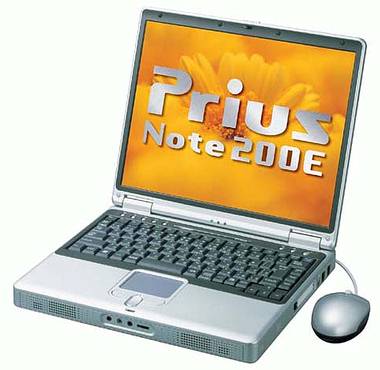 Prius Note 200E features integrated ATI RADEON IGP 320M + ALi 1535+ bundle with 16Mb video memory, 256Mb PC2100 DDR SDRAM (up to 512Mb), 30Gb HDD, DVD/CD-RW combo, 14.1" XGA LCD display, a number of interfaces: USB 1.1, IEEE1394, TV-Out, Ethernet 10/100BASE-TX, V.56kbps modem, etc.) Measured 309x263x43 mm, the model weighs 3.6kg. With Windows XP Home Edition SP1 and Office XP Personal the novelty will cost about $1400 in Japan late in February. Source: ASCII24
Bjorn3D reviews Belkin SOHO Keyboard/Video/Mouse Switch "Iíve used a generic, GVC, 2-port KVM switch and recently a 2-port D-Link KVM switch with moderate success. The model that Iím testing here, the OmniViewSOHO Series 4-Port KVM Switch with Audio PS/2 and USB Platform (Belkin Part Number: F1DS104T) brings my KVM experience to a whole new level since, as the title suggests, this model incorporates both audio (and microphone) and USB keyboard/mouse support. Kudos to Belkin for shipping my evaluation version with two packs of PS/2 patch cords and two packs of USB patch cords (audio cables included). With this review, Iím going to look at the features of KVMs and why Belkinís model is the best that Iíve tested." Read more at Bjorn3D!
Mosel Vitelic releases 256 ŐŠ DDR 400 Mosel Vitelic has also announced DDR 400 memory modules Ė 256Mb DDR 400 SDRAM.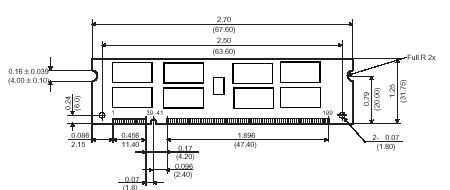 Mosel Vitelic solutions feature standard JEDEC SSTL-2 interface, 0.14Ķm TSOP and SOC (Substrate on Chip) BGA chips, and require 2.5V voltage. At 200MHz clock and 64-bit memory bus DDR 400 is claimed to provide 3.2Gb/s throughput.
IDF Spring 2003: on the prospects of Intel mobile platforms. The Digital Home concept As you can see this IDF is boiling with announcements and solution releases. Iím afraid the flow of information will be too strong, so we´ll have to mess with it until the next important industry event — CeBIT 2003 in Hannover. And now we continue to mix official press releases with information obtained from the Forum participants.Today Anand Chandrasekher, Vice President and General Manager of the Intel Mobile Platforms Group, officially announced that Intel Centrino, new companyís mobile platform, will be released on March, 12, at CeBIT 2003.
 Intel Centrino mobile design includes Intel Pentium M processor, Intel 855 chipset and Intel Pro/Wireless 2100 network interface. Pentium M (former Banias) features the improved Pentium III core, 1Mb L2 cache, 400MHz FSB. This lets me think that a Pentium M with a Pentium 4 FSB can work on the chipsets for the latter. According to Anandtech, thereís a Pentium M operating on Intel 7501 presented at IDF! 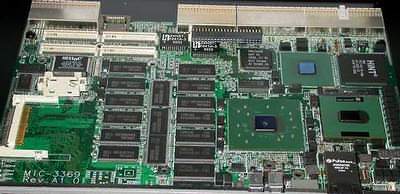 In his speech Anand Chandrasekher also informed that Intel Communications Fund had already invested $25 million into over 15 companies, working in wireless networking segment, to speed up the deployment of such solutions worldwide. Intel also collaborates with hotel networks, telecom providers and retail traders, and goes on with the program of public Wi-Fi access points for using with Intel Centrino technology. About several thousand of these are to be tested by the end of 2003. Intel also announced the 6-quarter Granite Peak program for providing compatibility between Intelís new chipsets and desktop/mobile processors. This will help IT departments to support standardized hardware and software for longer periods of time.
 Besides, Intel presented components for its Digital Home concept. These include a new reference platform codenamed Statesboro that features Linksys digital multimedia adapter based on Intelís reference design that provides digital content distribution via wireless home-wide channels. Statesboro is a demo-platform addressed to developers to illustrate the Digital Home concept of 2003. It includes all the key parts for supporting digital home models described in the Desktop Platform Vision Guide 2003. These include 3.06GHz Intel Pentium 4 with HyperThreading, Springdale chipset, 802.11 dual-band WLAN controller, Serial ATA hard drive, DDR memory and an optical DVD/CD-RW recorder. More on this: Intel also presented a new concept for 2004 codenamed Powersville that features digital home/office functionality.
 Another desktop concept expected in 2004 — Marble Falls Ė bases on Small Form Factor (SFF). Itís a dual-display PC with a built-in digital camera that features HT-enabled Pentium 4, i865 (Springdale) chipset, Gigabit Ethernet port, IEEE 802.11a, Bluetooth wireless interfaces, ATi Radeon 9000 Mobility graphics and Serial ATA hard drive. Marble Falls will support PCI Express (NewCard socket).
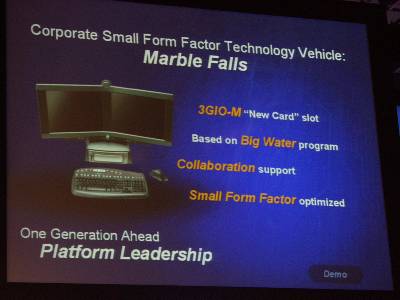  Finally, Intel Newport concept is a Centrino-based mobile tablet solution with IEEE 802.11a/b, GPRS, Bluetooth interfaces and detachable keyboard.
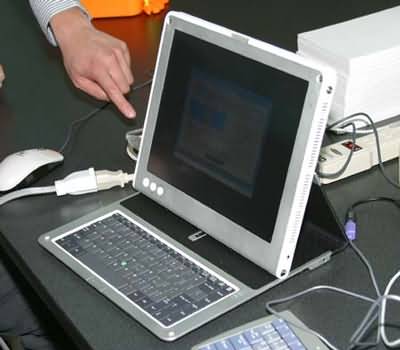 To speed up the development of digital multimedia adapters and digital home PC platforms Intel has already been producing a number of UPnP tools: Device Spy, Device Sniffer, Service Author, Device Validator, Device Relay, Network Light, AV Media Controller, AV Wizard, AV Media Server and AV Renderer.
IDF Spring 2003: Philips, Intel and Silicon Image release Serial ATA DVD+RW The wave of hard drive and controller announcements sometimes makes us count Serial ATA as an exclusive HDD interface. But actually itís a universal bus supporting very different peripherals. Philips, Intel and Silicon Image reminded about this at IDF Spring 2003, having presented the first DVD+RW with Serial ATA interface at Intelís booth.The novelty was showcased together with Intelís system on a new chipset with Serial ATA interface. Philipsís DVD+RW features SATALink SiI 3611 Serial ATA bridge provided by Silicon Image. This system enables to record video to DVD+RW media in real time. According to these companies, first Serial ATA optical drives will arrive in the end of 2003 to become mainstream by mid-2004. In Serial ATA DVD+RW development Philips collaborates with Silicon Image, Intel and BenQ.
Bridge and MiniCard: new extensions for PCI Express 
PCI-SIG (PCI Special Interest Group), promoter and supporter of PCI Express, PCI and PCI-X standards, today released provisional specs of two new extensions: PCI Express Bridge Release Candidate 1.0 and Mini PCI Release Candidate 1.0. Combined with PCI Express Card form-factor, MiniCard specs will be used in various wired/wireless comm peripherals. These specs are an alternative to existing Mini PCI. At the same time at IDF Intel announced product roadmap along with programs for speeding up PCI Express development and solutions release. In 2004 Intel plans to launch the volume production of PCI Express-based solutions, including chipsets and enterprise platforms, mobile and desktop systems, fully-featured I/O processors for high-performance RAID arrays, Ethernet adapters, data storage systems, next-generation motherboards and server platforms. At the same time Intel announced soon opening of PCI Express compatibility and interaction lab along with posting a catalog of solutions on the new technology. The lab is to open in by June 2003 to test compatibility of PCI Express solutions with Intel´s processors, chipsets and platforms.
IDF: a tidal wave of DDR400 announcements This day brought a real tidal wave of DDR400 PC3200 announcements along with messages about Intelís module certification. Below an all-in-one compilation for you.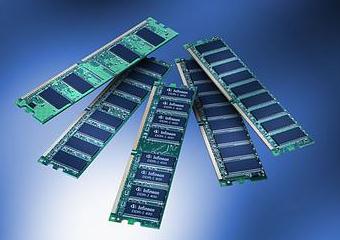 Infineon Technologies AG announced a family of unbuffered DIMM with 128Mb, 256Mb and 512Mb capacities based on 256Mbit DDR400. Modules are certified to meet Intelís requirements for this memory type a well as JEDEC PC3200 3.2 GBps specs. Module chips are made on 200mm and 300mm pipelines using 0.14Ķm process technology. Shipments have already started. Depending on capacity in quantities chips cost from $30 to $100. Sample consignments of 256Mbit DDR400 chips are offered for $6 per unit. Samsung Electronics announced that its DDR400 modules had passed Intelís qualification tests for compatibilty with Springdale. Another Korean maker Hynix Semiconductor, announced that its 256Mbit DDR400 had also been certified by Intel. Currently the company ships 256Mbit DDR400 chips in volumes, also shipping 512Mbit DDR400 as samples. Elpida Memory announced shipments of 256Mbit DDR400 SDRAM and unbuffered PC3200 DIMM modules. Naturally, all these fully meet Intelís requirements.
Elpida´s 256Mbit DDR400 SDRAM are made using 0.13Ķ process technology, are organized as 32Ő x 8-bits x 4 banks and packed into TSOP bodies. DIMMs are available in 256Mb and 512Mb capacities, organized x64 or x72 (ECC / non-ECC). Volume shipments are scheduled to April 2003. Kingston Technology announced its DDR400 (PC3200) modules had passed Intelís qualification tests. These are listed below: KVR400X64C3/256 256MB 400MHz DDR DIMM, CL 3
  As you know, DDR400 is still a semi-official standard, as JEDEC hasnít ratified its final specs yet. Intel found an elegant way out, having posted Intel Specification Addendum for JEDEC DDR400 Specification on its website. Meanwhile, it has also posted a constantly updated page of certified DDR400 modules: Intel DDR400 Validation Testing. So, we can state weíve mentioned all the makers listed there. As for still invalidated but interesting DDR400 modules, I should mention Kingmax SuperRAM chips and modules, packed into TinyBGA bodies (the photo below taken from PC POP).
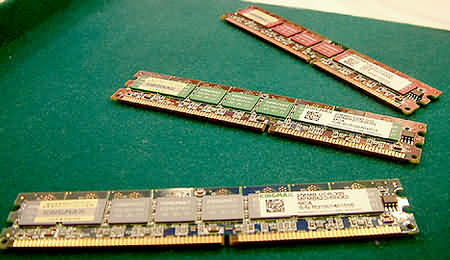
Write a comment below. No registration needed!
|
Platform · Video · Multimedia · Mobile · Other || About us & Privacy policy · Twitter · Facebook Copyright © Byrds Research & Publishing, Ltd., 1997–2011. All rights reserved. |